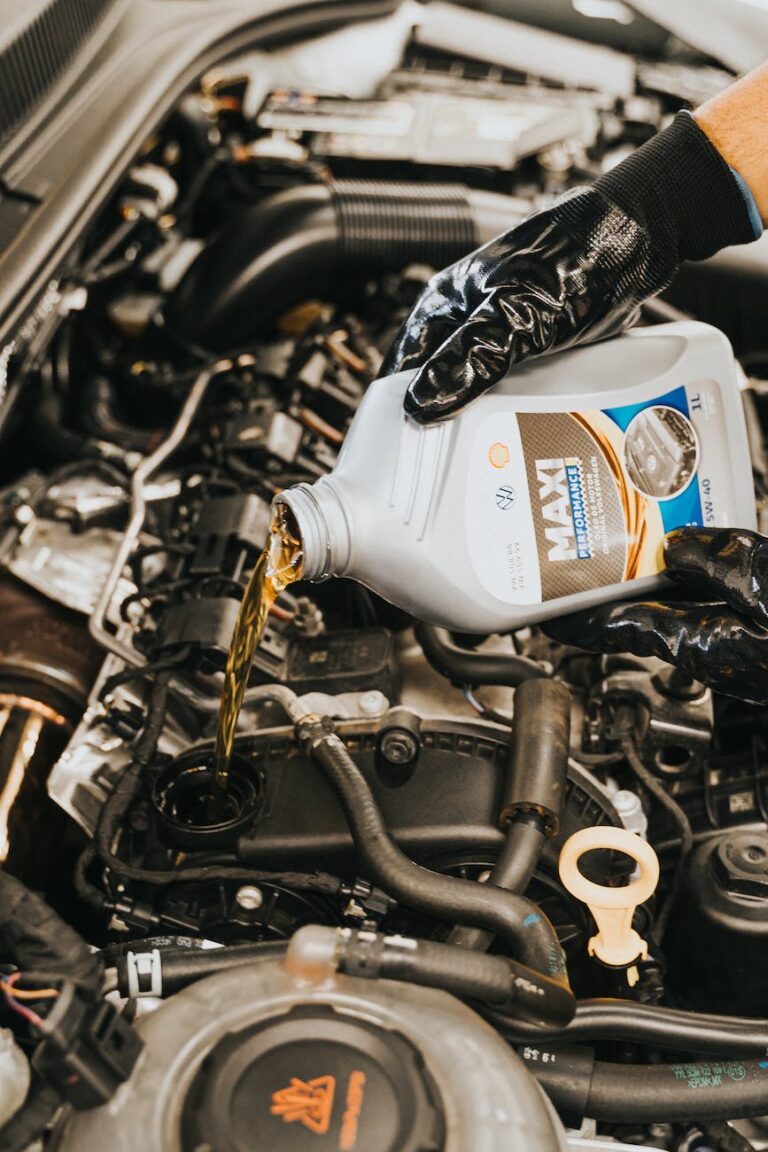The Importance of Oil Changes
Regular oil changes are crucial for maintaining the health and performance of your car’s engine. By providing essential lubrication, oil helps to reduce friction between moving parts, preventing excessive wear and tear. Let’s explore the significance of oil changes in terms of engine lubrication and protection, as well as preventing engine damage and costly repairs.
Engine Lubrication and Protection
Oil plays a vital role in lubricating the engine components, such as pistons, cylinders, and valves. As these parts move and rub against each other, the oil forms a protective barrier, reducing friction and heat generation. This lubrication prevents metal-to-metal contact and minimizes wear on the engine, allowing it to function smoothly and efficiently.
Over time, however, engine oil can break down and become less effective due to exposure to high temperatures and contaminants. As a result, it loses its ability to provide adequate lubrication, leading to increased friction and potential damage to critical engine parts.
Preventing Engine Damage and Costly Repairs
Regular oil changes are essential to prevent engine damage and costly repairs. As oil ages, it becomes contaminated with dirt, debris, and other particles, forming sludge that can clog oil passages and hinder proper lubrication. This can result in decreased engine performance, reduced fuel efficiency, and even engine failure.
Neglecting regular oil changes can also lead to the buildup of harmful deposits on engine components, such as the pistons and valves. These deposits can interfere with the smooth operation of the engine, affecting its overall performance and potentially causing costly damage.
By adhering to recommended oil change intervals, you can ensure that your engine is consistently supplied with clean and effective lubrication. Following the manufacturer’s guidelines and considering factors such as driving conditions and mileage will help determine the appropriate frequency for oil changes.
To learn more about the recommended oil change intervals and factors affecting oil change frequency, check out our article on oil change services.
Regular oil changes are a small investment in the long-term health of your vehicle. By keeping your engine properly lubricated and protected, you can enjoy improved engine performance, extended engine lifespan, and better fuel efficiency. Don’t overlook the importance of this simple maintenance task, as it can save you from costly repairs and keep your car running smoothly for years to come.
Types of Engine Oil
When it comes to engine oil, there are several options available, each with its own unique characteristics and benefits. Understanding the differences between these types of oil can help you make an informed decision when it’s time for an oil change. Let’s explore four common types of engine oil: conventional oil, synthetic oil, synthetic blend oil, and high mileage oil.
Conventional Oil
Conventional oil, also known as mineral oil, is the traditional type of engine oil. It is derived from crude oil and undergoes refining and additives to meet industry standards. Conventional oil provides adequate lubrication and protection for most common engines. It is an affordable option for regular maintenance, making it a popular choice among car owners.
However, it’s important to note that conventional oil may not offer the same level of performance and protection as synthetic oils, especially in extreme temperatures. Regular oil changes with conventional oil are typically recommended every 3,000 to 5,000 miles, depending on driving conditions and manufacturer recommendations.
Synthetic Oil
Synthetic oil is a man-made lubricant formulated through a complex process. It offers better performance and protection for modern engines compared to conventional oil. Synthetic oil is known for its superior viscosity stability and resistance to breakdown, which helps to maintain optimal engine performance, even in extreme temperatures.
Synthetic oil provides improved lubrication, reduces friction, and enhances fuel efficiency. It also offers better resistance to oxidation and sludge formation compared to conventional oil. Although synthetic oil is more expensive, its benefits in terms of engine protection and longevity make it a popular choice among car enthusiasts and those seeking optimal performance.
The oil change interval for synthetic oil can be longer than conventional oil, with some manufacturers recommending changes every 10,000 to 15,000 miles. However, it’s important to follow the specific recommendations outlined in your vehicle’s owner’s manual or consult with a trusted mechanic.
Synthetic Blend Oil
Synthetic blend oil, also known as semi-synthetic oil, is a mixture of conventional and synthetic oil. This type of oil offers a balance between cost and performance. Synthetic blend oil combines the enhanced protection and performance benefits of synthetic oil with the affordability of conventional oil.
Synthetic blend oil can provide better protection against engine wear and improved performance compared to conventional oil. It is often recommended for vehicles that operate under more demanding conditions or for those seeking a middle ground between conventional and synthetic oils.
The oil change interval for synthetic blend oil is typically similar to that of conventional oil, ranging from 3,000 to 5,000 miles. However, it’s essential to refer to your vehicle’s manufacturer recommendations for the most accurate oil change interval.
High Mileage Oil
High mileage oil is specially formulated for vehicles with 75,000 miles or more on the odometer. As vehicles age, they may experience increased oil consumption, leaks, and engine wear. High mileage oil is designed to address these concerns and provide additional protection for aging engines.
This type of oil contains additives that help reduce oil consumption, condition engine seals, and minimize wear on older engine components. High mileage oil can help extend the life of your engine and improve overall performance.
The oil change interval for high mileage oil is typically similar to conventional oil, ranging from 3,000 to 5,000 miles. However, it’s important to consult your vehicle’s manufacturer recommendations or a trusted mechanic for guidance specific to your vehicle’s needs.
Choosing the right type of engine oil depends on various factors, including your vehicle’s age, mileage, and manufacturer recommendations. By understanding the characteristics of each type of oil, you can make an informed decision that suits your car’s specific needs and ensures optimal engine performance and longevity.
Recommended Oil Change Intervals
When it comes to automotive oil changes, it’s essential to understand the recommended intervals for changing your vehicle’s engine oil. Gone are the days of the outdated oil change myth that stated you should change your oil every 3,000 miles or every 3 months. Modern vehicles and advancements in oil technology have allowed for longer oil change intervals.
Outdated Oil Change Myths
The conventional wisdom of changing oil every 3,000 miles or 3 months is no longer applicable to most vehicles (Car and Driver). This myth originated from older vehicles that had different engine designs and less advanced oil formulations. Modern engines and improved oil quality have significantly extended the interval between oil changes.
Manufacturer Recommendations
Today, the majority of automakers recommend oil changes between 7,500 and 10,000 miles or once a year for newer vehicles (Car and Driver). However, it’s important to note that manufacturer recommendations may vary based on the specific make and model of your vehicle. To determine the recommended oil change interval for your car, it’s best to consult the owner’s manual or contact the manufacturer directly.
Factors Affecting Oil Change Frequency
While following the manufacturer’s guidelines for oil change intervals specified in the vehicle’s owner’s manual is crucial, it’s essential to consider other factors that can affect the frequency of oil changes. These factors include:
- Driving Conditions: Frequent short trips, stop-and-go city driving, or towing heavy loads can put additional stress on the engine and may require more frequent oil changes.
- Environment: Extreme temperatures, both hot and cold, can influence the performance and degradation of engine oil. If you live in an area with extreme climate conditions, it may be necessary to adjust the oil change interval accordingly.
- Oil Type: The type of oil used in your vehicle can also impact the recommended oil change interval. Synthetic oils, for example, can last longer than conventional oils and may only need to be changed every 10,000 to 15,000 miles (Car and Driver). However, it’s important to follow the guidelines set by the oil manufacturer.
By taking these factors into account, you can determine the appropriate oil change frequency for your vehicle. Always prioritize following the manufacturer’s recommendations and guidelines to ensure optimal engine performance and longevity.
To find oil change services near you, check out our directory for affordable and reliable options. Regular oil changes are an essential part of car maintenance, contributing to improved engine performance, extended engine lifespan, and better fuel efficiency. Stay informed about the specific needs of your vehicle and enjoy the benefits of a well-maintained engine.
Signs That Your Car Needs an Oil Change
Regularly monitoring the condition of your vehicle’s oil is essential to ensure optimal engine performance and longevity. Here are several signs that indicate it’s time for an oil change:
Illuminated Oil Change Light
One of the most common indicators that your car needs an oil change is the illumination of the oil change light on your dashboard. This light is designed to alert you when the oil’s level or quality has deteriorated and needs attention. In some cases, the check engine light may also illuminate, signaling a risk of engine damage (Machinery Lubrication). If you notice the oil change light or check engine light is on, it’s important to schedule an oil change as soon as possible to prevent potential engine issues.
Unusual Engine Noises
If you start hearing unusual engine noises such as knocking, rumbling, or ticking sounds, it could be an indication that the oil is not effectively lubricating the engine. Engine components rely on proper lubrication to reduce friction and prevent damage. When the oil becomes old and loses its viscosity, it can no longer provide adequate lubrication, leading to increased engine noise (Machinery Lubrication). If you notice any unusual noises coming from your engine, it’s advisable to have your oil changed promptly.
Dark and Dirty Oil
As the oil circulates through the engine, it picks up dirt, debris, and contaminants, causing it to turn darker in color. Regularly checking the oil’s color and visibility on the dipstick can help determine its condition. If the oil appears excessively dark, thick, or gritty, it is an indication that it has become dirty and reached its maximum capacity to effectively lubricate the engine (Machinery Lubrication). In such cases, an oil change is necessary to maintain engine health.
Smell of Oil or Exhaust
If you notice a strong smell of oil inside the car, it may indicate an oil leak. Oil leaks can lead to a decrease in oil levels, affecting the engine’s lubrication and potentially causing damage. Additionally, if you detect the smell of gas or exhaust fumes, it may suggest overheating or other engine issues. Both scenarios require immediate attention and maintenance (Machinery Lubrication). It’s crucial to address these smells promptly to prevent further damage to your vehicle.
Smoke from the Tailpipe
If you observe smoke coming from the tailpipe of your car, it may indicate underlying engine problems or an oil leak. The translucent vapor that typically exits the tailpipe should not transform into smoke. Smoke can be a sign of faulty engine parts or an oil leak, both of which necessitate an engine check-up and potential oil change (Machinery Lubrication).
By being attentive to these signs, you can identify when your car requires an oil change and take the necessary steps to keep your engine running smoothly. Regular oil changes play a vital role in maintaining engine performance, preventing damage, and extending the lifespan of your vehicle. If you notice any of these signs, it’s recommended to schedule an oil change promptly to protect your engine’s health.
The Process of an Oil Change
When it comes to automotive oil change, understanding the process is essential for maintaining the health and performance of your vehicle. An oil change involves several steps, including draining the old oil, replacing the oil filter, and adding fresh oil.
Draining the Old Oil
The first step in an oil change is to remove the old oil from the engine. This is typically done by locating the drain plug or valve on the oil pan, which is situated at the bottom of the engine. By placing a drain pan beneath the vehicle, the drain plug can be loosened or the valve can be opened to allow the old oil to flow out (Car and Driver).
It’s important to exercise caution during this step to prevent any spills or burns. Once the old oil has been completely drained, the drain plug or valve should be securely tightened to prevent leaks.
Replacing the Oil Filter
The oil filter plays a crucial role in removing contaminants from the oil, ensuring optimal engine performance. During an oil change, it’s recommended to replace the old oil filter with a new one to maintain the cleanliness of the oil circulating through the engine (Car and Driver).
The process of changing the oil filter involves locating the filter housing, which is typically found near the engine block. After removing the old filter, the filter housing should be cleaned to remove any residue or debris. Once cleaned, a new filter can be installed, ensuring a proper seal.
Adding Fresh Oil
Once the old oil has been drained and the oil filter replaced, it’s time to add fresh oil to the engine. The type and viscosity of oil to be used should be in accordance with the specifications provided by the car manufacturer. This information can typically be found in the owner’s manual or by consulting a professional (Performance Honda Store).
The fresh oil is poured into the engine through the oil fill cap or valve cover, which is usually located on the top of the engine. It’s important to pour the oil slowly and carefully, ensuring that the correct amount is added. Overfilling or underfilling the engine with oil can lead to performance issues and potential damage.
During the oil change process, it’s crucial to handle the used oil with care. Used oil should be disposed of properly to prevent environmental contamination. Many service centers and automotive stores offer oil recycling programs to ensure the responsible disposal of used oil.
By following the proper procedures and using the appropriate tools and materials, an oil change can be successfully performed. However, if you’re not comfortable completing an oil change on your own, it’s recommended to seek the assistance of a professional oil change service. They have the expertise and equipment to ensure a proper and efficient oil change, helping to keep your vehicle running smoothly and extending its lifespan.
Choosing the Right Oil for Your Car
When it comes to selecting the appropriate oil for your car, there are several factors to consider. Following the manufacturer’s specifications, understanding the differences between synthetic and conventional oil, and being familiar with viscosity ratings are all essential aspects in making the right choice.
Following Manufacturer Specifications
To ensure optimal performance and protection for your vehicle, it is crucial to follow the oil recommendations provided by the car manufacturer. They specify the type of oil and viscosity grade that best suits your engine’s requirements. The manufacturer’s specifications can be found in the owner’s manual or on the manufacturer’s website.
Using the recommended oil ensures compatibility with your engine’s design and components, providing the necessary lubrication and protection. Deviating from the manufacturer’s specifications can potentially lead to engine damage or voiding of warranty coverage.
Considering Synthetic vs. Conventional Oil
One of the key decisions to make when selecting oil is choosing between synthetic and conventional oil. Synthetic oil, although more expensive, offers better performance and protection, especially in extreme temperatures (Car Care Blog). It is chemically engineered to be more consistent and high-performing, reducing friction, withstanding high temperatures, and improving fuel efficiency and horsepower (Tom’s Auto Center).
On the other hand, conventional oil is made from crude oil and undergoes refining and additives to meet industry standards. It is recommended for older-model vehicles with less complex engine designs and typically requires more frequent changes compared to synthetic oil (Car Care Blog).
Synthetic blend oil, a mixture of conventional and synthetic oil, offers a balance between cost and performance. It provides some of the benefits of synthetic oil at a more affordable price point (Car Care Blog).
Understanding Viscosity Ratings
Viscosity ratings are another important consideration when selecting oil for your car. Viscosity refers to the oil’s resistance to flow at different temperatures. The Society of Automotive Engineers (SAE) assigns a viscosity grade to each oil type, typically represented by a combination of numbers and letters such as 5W-30 or 10W-40.
The first number before the “W” indicates the oil’s viscosity in cold temperatures, while the second number represents its viscosity at operating temperatures. Lower numbers indicate lower viscosity or thinner oil, which flows more easily in cold weather. Higher numbers indicate higher viscosity or thicker oil, which provides better protection at high temperatures.
It is crucial to select the viscosity grade recommended by the manufacturer for your specific vehicle and driving conditions. Using the wrong viscosity oil can impact engine performance and potentially cause damage.
By following the manufacturer’s specifications, considering the differences between synthetic and conventional oil, and understanding viscosity ratings, you can make an informed decision when choosing the right oil for your car. Remember, regular oil changes using the proper oil are essential for maintaining the longevity and performance of your vehicle’s engine.
Proper Disposal of Used Oil
When it comes to oil changes, it’s not just about the benefits to your car’s performance and longevity. Properly disposing of used oil is crucial to protect the environment and prevent contamination of water sources. Neglecting regular oil changes can lead to a buildup of sludge and deposits in the engine, reducing its efficiency and potentially causing costly damage (Progressive). In this section, we will discuss the environmental impact of improper oil disposal and the importance of recycling and proper disposal methods.
Environmental Impact of Improper Disposal
Improper disposal of used oil can have severe consequences for the environment. Used oil contains harmful substances such as heavy metals, toxic chemicals, and other pollutants that can contaminate soil and water if not handled correctly. When oil is dumped down drains or improperly discarded, it can find its way into rivers, lakes, and groundwater, posing a significant risk to aquatic life and ecosystems.
Furthermore, used oil that is not disposed of properly can seep into the ground, contaminating soil and potentially affecting plant growth and agriculture. It is essential to remember that even a small amount of oil can have a detrimental impact on the environment.
Recycling and Proper Disposal Methods
To protect the environment and ensure the safe disposal of used oil, it is crucial to recycle it properly. Used oil can be recycled and reused in various ways. Many auto parts stores and recycling centers accept used oil for recycling. You can check with your local recycling center or auto parts store to find a collection point near you.
When disposing of used oil, it’s important to follow these steps:
- Store the used oil in a clean, leak-proof container that is specifically designed for oil storage. Avoid using containers that previously held chemicals or food products.
- Take the used oil to a certified recycling center or an auto parts store that accepts it. These facilities have the proper equipment and processes to handle and recycle the oil safely.
- Do not mix used oil with other substances, such as antifreeze or brake fluid. These substances require separate disposal methods.
- Never pour used oil down drains, toilets, or into the ground. This can lead to environmental contamination and damage.
By following these proper disposal methods, you can contribute to the preservation of the environment and the protection of water sources.
Remember, responsible oil disposal is not only an ethical choice but also a legal requirement in many jurisdictions. By doing your part, you can help minimize pollution, protect natural resources, and ensure a cleaner and healthier environment for future generations.
Proper disposal is just one aspect of the oil change process. If you’re interested in learning more about oil changes, including the benefits of regular oil changes and how to choose the right oil for your car, continue reading our comprehensive guide to automotive oil changes.
The Benefits of Regular Oil Changes
Regular oil changes are crucial for maintaining the health and performance of your car’s engine. By adhering to the recommended oil change intervals, you can experience several key benefits that contribute to the overall longevity and efficiency of your vehicle.
Improved Engine Performance
One of the primary benefits of regular oil changes is improved engine performance. Engine oil plays a vital role in lubricating the various moving parts within the engine, reducing friction and minimizing wear and tear. Over time, the oil can become contaminated with dirt, debris, and metal particles that can hinder its ability to effectively lubricate the engine.
By replacing the old, dirty oil with fresh oil during an oil change, you ensure that the engine is properly lubricated. This allows the engine components to move smoothly and efficiently, reducing friction and maximizing performance. With improved engine performance, you can experience smoother acceleration, better responsiveness, and overall enhanced driving experience.
Extended Engine Lifespan
Regular oil changes also contribute to extending the lifespan of your car’s engine. The engine is a complex and intricate system with many components working together. Over time, the oil can break down and lose its lubricating properties, leading to increased friction and potential damage to the engine parts.
By changing the oil at recommended intervals, you remove the contaminants that can cause engine damage and wear. Fresh oil helps to maintain optimal lubrication, reducing friction and minimizing the risk of premature engine failure. With proper lubrication, the engine can operate smoothly and efficiently, ultimately prolonging its lifespan and saving you from costly repairs.
Better Fuel Efficiency
Another significant benefit of regular oil changes is improved fuel efficiency. When the engine is properly lubricated with clean oil, it operates more efficiently, requiring less energy to function. This efficiency translates into better fuel economy, as a well-lubricated engine experiences reduced friction and performs optimally.
Old, dirty oil that has degraded over time can cause the engine to work harder, leading to decreased fuel efficiency. By replacing the oil regularly, you ensure that the engine operates smoothly, reducing the strain on the engine and allowing it to use fuel more efficiently. As a result, you can enjoy better mileage and potentially save money on fuel costs.
By prioritizing regular oil changes, you can reap these benefits, including improved engine performance, extended engine lifespan, and better fuel efficiency. Remember to follow the manufacturer’s recommendations for oil change intervals and consult your vehicle’s owner’s manual for specific guidelines. With routine maintenance and timely oil changes, you can keep your car running smoothly and enjoy a longer, more efficient life for your engine.
Learning to Change Your Own Oil
While many car owners rely on professional oil change services for routine maintenance, learning to change your own oil can be a valuable skill. Not only does it give you a sense of self-sufficiency, but it can also save you time and money in the long run. If you’re interested in taking on the task of changing your own oil, there are a few options for gaining the necessary knowledge and skills.
Foundation Training for Automotive Service Technicians
Aspiring Automotive Service Technicians can start their journey by enrolling in a Foundation training course. Institutions like TRU’s School of Trades and Technology offer such courses, which cover basic oil changes as one of the early lessons. These courses provide students with limited mechanical experience the skills they need to become an Apprentice Mechanic, with a strong emphasis on hands-on projects for practical training (TRU Newsroom). The programming covers various automotive topics such as general shop practice, engines, electrical systems, steering systems, and braking systems, among others (TRU Newsroom).
Apprenticeship Programs for Skill Development
For individuals interested in pursuing a career as an Automotive Service Technician, further levels of apprenticeship programs are available. These programs, such as those offered by TRU’s School of Trades and Technology, provide in-depth training and education for aspiring technicians at levels 2, 3, and 4. These programs build upon the foundation training and cover advanced topics, allowing apprentices to develop a comprehensive understanding of automotive systems (TRU Newsroom). Attending information sessions like Trades & Tech Thursdays at TRU can provide valuable insights into the available trades and technology programs, including Automotive Service Technician training (TRU Newsroom).
Considering DIY Oil Changes
For car owners who prefer a more hands-on approach to vehicle maintenance, DIY oil changes can be a viable option. Resources such as online tutorials, instructional videos, and automotive forums provide step-by-step guides on how to change your own oil. Before attempting a DIY oil change, it’s essential to gather the necessary tools, including a jack or ramps, an oil filter wrench, an oil drain pan, and new oil and oil filter.
Keep in mind that changing your own oil requires a certain level of mechanical aptitude and attention to detail. It’s important to follow the manufacturer’s guidelines for oil type, oil filter, and oil change intervals. Adhering to proper safety procedures, such as securely lifting and supporting the vehicle, is also crucial. If you are uncertain or uncomfortable with any aspect of the process, it’s always wise to seek professional assistance.
By learning to change your own oil, you can take a proactive role in maintaining your vehicle’s health. It provides an opportunity to familiarize yourself with the inner workings of your car and saves you a trip to a mechanic for routine maintenance like an oil change. However, it’s important to weigh the benefits against your comfort level and technical expertise. Whether you choose to perform your own oil changes or rely on professional services, regular oil changes are vital for the longevity and performance of your vehicle.







